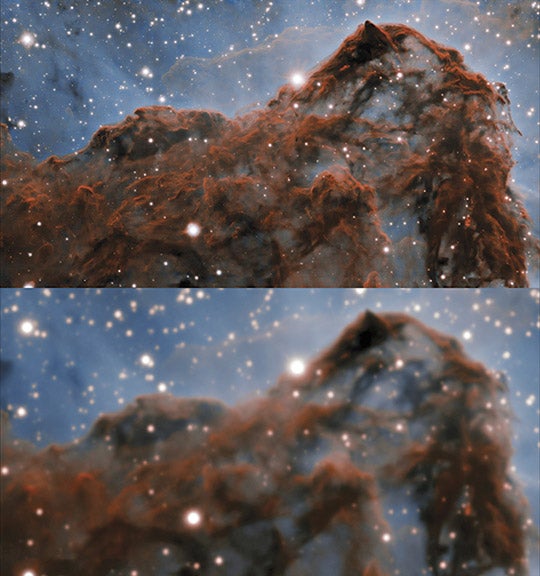
Carina Close-Up
A blur-correcting camera lets Gemini South telescope take crystal-clear images of star-forming nebula.
By Jade Boyd

An adaptive optics camera at the Gemini South telescope in Chile has provided astronomers with images as clear as those taken from a telescope in orbit.
The camera corrects for distortion from Earth’s atmosphere and allowed Rice’s Patrick Hartigan and Andrea Isella and Dublin City University’s Turlough Downes to capture near-infrared images of the Carina Nebula with the same resolution that’s expected of NASA’s James Webb Space Telescope, which is slated to launch in late 2021.
Hartigan, Isella and Downes described their work in a study published online last fall in Astrophysical Journal Letters. It took about 10 hours to gather the wide-field images from the 8.1-meter telescope in January 2018. The work at the international Gemini Observatory, a program of the National Science Foundation’s NOIRLab, provided the clearest view yet of a stellar nursery where new stars are forming about 7,500 light years from Earth.
“The results are stunning,” Hartigan said. The Carina images show a molecular cloud of dust and gas known as the Western Wall. All stars, including Earth’s sun, are thought to form within molecular clouds.
The cloud’s surface is slowly evaporating in the intense glow of radiation from a nearby cluster of massive young stars. The radiation causes hydrogen to glow with near-infrared light, and specially designed filters allowed the astronomers to capture separate images of hydrogen at the cloud’s surface and hydrogen that was evaporating. An additional filter captured starlight reflected from dust.
The new images of it are so much sharper than anything we’ve previously seen,” he said. “They provide the clearest view to date of how massive young stars affect their surroundings and influence star and planet formation.
Combining the images allowed the trio to visualize how the cloud and cluster are interacting. Hartigan has previously observed the Western Wall with other NOIRLab telescopes. “The new images of it are so much sharper than anything we’ve previously seen,” he said. “They provide the clearest view to date of how massive young stars affect their surroundings and influence star and planet formation.”
Images of star-forming regions taken from Earth are usually blurred by atmospheric turbulence. Placing telescopes in orbit eliminates that problem, and so does adaptive optics, which uses “a mirror that changes its shape to correct for shimmering in our atmosphere,” Hartigan said. The result: photos with roughly 10 times the resolution of images taken from ground-based telescopes that don’t use adaptive optics.
But the atmosphere also blocks some near-infrared light. Hartigan said those wavelengths will only be visible from a space telescope like the Webb.
“Structures like the Western Wall are going to be rich hunting grounds for both Webb and ground-based telescopes with adaptive optics like Gemini South,” Hartigan said. “Each will pierce the dust shrouds and reveal new information about the birth of stars.”
